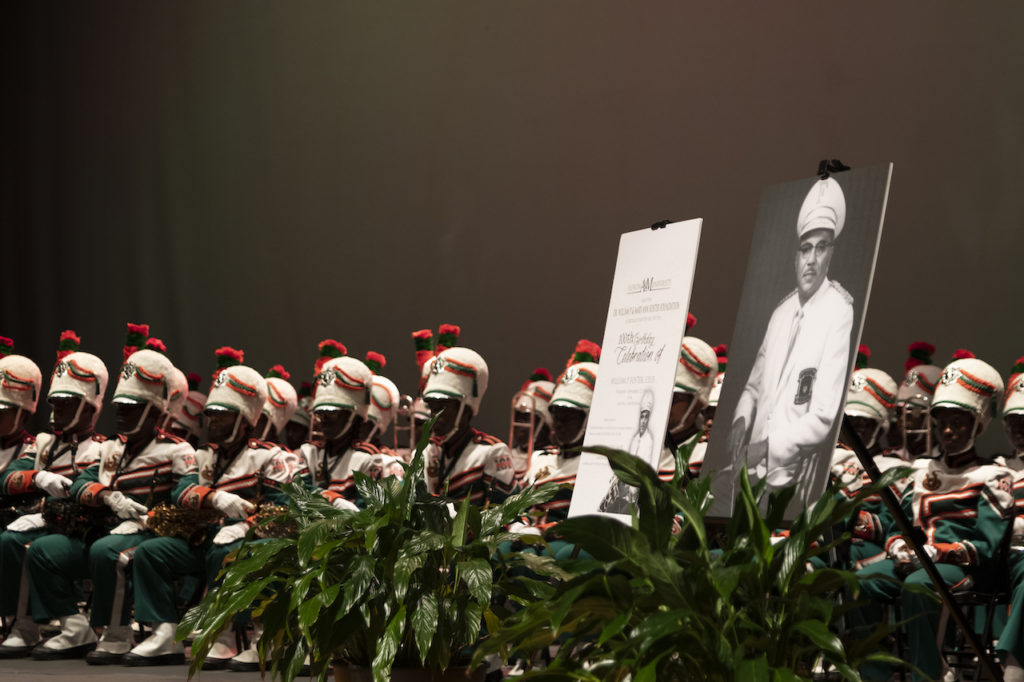
The Florida A&M University community celebrated the 100th birthday of Marching “100” founder William P. Foster with music, alumni tributes and the unveiling of portraits and memorabilia destined for the Smithsonian museums in Washington, D.C.
Hosted by the Dr. William P. and Mary Ann Foster Foundation at Lee Hall Auditorium, the Thursday event featured tributes from five band alumni: Lindsey Sarjeant, chairman of the Music Department, former band directors, Sylvester Young, Ph.D., and Julian White, Ph.D., current band director Shelby Chipman, Ph.D., and Adam J. Richardson, former Marching 100 drum major and senior bishop of the African Methodist Episcopal (AME) Church.
Each spoke of Dr. Foster’s mentorship and his ability to see their talent even when they may have doubted themselves.
“I am a better man, professional and perhaps a better preacher because of Dr. Foster,” Richardson said.

Perhaps the highlight of the evening was the digital display of two of Dr. Foster’s portraits that are headed for the National Portrait Gallery. One is a familiar portrait of Dr. Foster in his band uniform. The other is a group photo from 1968 that shows Foster standing in a group of band members, including Richardson in his drum major uniform.
Ann Shumard, senior curator of photographs, said Dr. Foster was first proposed to the gallery in 2015. Dr. Foster’s photo will be joined with Earth, Wind, and Fire and Frances Arnold and will remain on display until August 2020. The photos will be included among those of African-American jazz drummer Chip Webb, bandleader Duke Ellington and composer Leonard Bernstein.
Dr. Foster’s son, Anthony Foster, CEO of the Foster Foundation, donated six items to the Smithsonian Institution National Museum of African American History and Culture (NMAAHC).
“I’m so proud to be here to represent the family,” Foster said. “I want to thank the present and past members for maintaining that legacy that started in 1946. My dad had the vision to excite the crowd to make them want more but leave them with wanting more.”
Addressing the audience, Joanne Hyppolite, Ph.D., an NMAAHC supervisory museum curator, said the donated items – including Dr. Foster’s baton, his jacket, a Marching “100” band uniform, and a trumpet case – will be added to the Musical Crossroads exhibition to reflect the importance of Dr. Foster’s contributions to American music and the stature of the Marching “100” among college marching bands.
“We are proud to have the recent addition of the aspirational and inspirational Dr. Foster and the Marching ‘100,’” said Hyppolite. She loved how the uniform represents the original 16 and the “100” today. “We are honored to share FAMU’s legacy at our museum,” she added.
Dr. Foster came to what was then Florida A&M College (FAMC) from Fort Valley State in 1946 to begin a career that lasted more than half a century. From an initial 16 members, the Marching “100” grew to 45 members, then to more than 100 members. The man known as “The Law” and “Maestro,” retired in 1998. He died on Aug. 28, 2010 at age 91. The Marching “100,” what Dr. Foster has called “the Lena Horne of Bands,” has grown to 270 members, including 120 freshmen.
In remarks near the end of the evening, President Larry Robinson, Ph.D., captured the significance of the event honoring Dr. Foster.
“This is a special day for the life of FAMU. This is still America’s band, the best band in the land,” said Robinson as he praised the legendary bandleader’s vision and contributions.
“Dr. Foster wasn’t perturbed by the struggles during his time because he knew he had to get us to 2019 and beyond. Dr. Foster’s reach transcended space and time. There is a William P. Foster in each and every one of the men and women who are part of the Marching “100” right here.”
